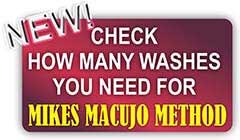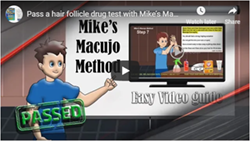Last Updated on April 12, 2024
Is a hair follicle drug test all that separates you from landing your dream job? With such high stakes, the pressure to successfully navigate through this hurdle can be overwhelming. Millions of drug tests are conducted each year, and a growing percentage of these are hair follicle tests.
But here's the silver lining: the advancement in detoxification methods and products has opened up new avenues for individuals seeking to pass these tests with flying colors.
But how reliable are these methods? Can a detox shampoo truly cleanse your hair of drug traces and help you pass a hair follicle test? And what exactly is the Macujo method, a term that seems to be on the lips of everyone facing this daunting challenge?
Join us as we answer your burning questions below.
What Exactly Is a Hair Follicle Drug Test?
A hair follicle drug test, often considered the gold standard in drug testing, is a meticulous procedure used to detect the presence of drug metabolites within the hair shaft. Hair tests provide a longer detection window, typically up to 90 days, offering a more comprehensive view of an individual's drug history. This is because drugs in the bloodstream become part of hair cells as they grow, leaving a lasting record of drug use.
When you consume drugs, your body metabolizes them, leaving behind specific markers or metabolites. These metabolites enter the blood vessels of the scalp, where they are filtered and retained by the growing hair cells.
As your hair grows, these drug metabolites become encased in the hair shaft, providing a timeline of drug use. During the test, a small sample of hair, usually from the crown of the head, is collected and analyzed for drug metabolites using sophisticated techniques such as enzyme-linked immunosorbent assay (ELISA) and gas chromatography-mass spectrometry (GC-MS).
Hair follicle tests can detect a wide range of drugs, making them highly versatile. Commonly detected substances include:
- Amphetamines, including:
- Methamphetamine
- MDMA (ecstasy)
- MDA
- Cocaine, including its metabolites like benzoylecgonine
- Opiates, such as:
- Heroin
- Codeine
- Morphine
- Phencyclidine (PCP)
- Marijuana (THC)
- Prescription drugs, including:
- Xanax
- Opioids like Oxycodone and Hydrocodone
- Fentanyl
This broad spectrum makes hair follicle testing particularly valuable in various contexts, from employment screening to legal cases.
What Are Drug Testing Panels and Why Do They Matter?
Drug testing panels refer to the specific groups of drugs that a test is designed to detect. Panels can range from a basic 5-panel test, which screens for the most common drugs (amphetamines, cocaine, marijuana, opiates, and PCP), to more extensive panels that can detect a wider array of substances, including prescription drugs and synthetic opioids.
The choice of panel matters because it determines the breadth of the detection capability of the test. Employers, legal entities, or medical professionals select panels based on the specific substances they are most interested in detecting. A more comprehensive panel is crucial in contexts where a wider range of drug use might be relevant, while a basic panel might suffice for routine employment screening.
Why Is Passing a Hair Follicle Drug Test So Challenging?
Passing a hair follicle drug test presents significant challenges because of the way the body embeds drug metabolites into the hair. Once these metabolites enter the hair shaft from the bloodstream, they become trapped, creating a lasting record of drug use. This permanence makes it hard to conceal or remove evidence of drug consumption without specific detox methods.
In hair, drugs can remain detectable for a substantial period, generally up to 90 days after last use. This is because scalp hair grows at an average rate of about 0.5 inches per month, and laboratories usually test the most recent 1.5 inches of growth. However, drugs can stay in the hair shaft indefinitely if you don't cut the hair. The lengthy detection period greatly increases the challenge of passing a hair test.
What Makes Hair Tests More Difficult to Pass Than Other Drug Tests?
The hair sample collection process is hard to manipulate. A professional collects the hair directly from the person, making it nearly impossible to substitute or alter the sample.
Hair tests can detect very small amounts of drug metabolites, capturing even minor or sporadic drug use.
Unlike flushing drugs from your system as you might for urine or saliva tests, drugs in the hair remain until you cut the hair. This means detoxifying for a hair test requires targeted treatments that either mask or remove the metabolites from the hair itself.
People facing a hair follicle drug test often turn to intensive detoxification methods, like specialized detox shampoos or the Macujo method. These strategies aim to mask or eliminate the drug metabolites, requiring:
- Accurate application
- Suitable products
- Sufficient preparation time
Can Detox Shampoos Truly Clear Your Hair of Drugs?
Detox shampoos claim to cleanse your hair of drug metabolites, offering a potential solution for passing a hair follicle drug test. While individual results can vary, certain high-quality detox shampoos have shown effectiveness in reducing the detectability of drugs in hair, especially when users apply them as part of a comprehensive detox strategy.
Detox shampoos work by targeting the outer layer of the hair shaft, known as the cuticle, to reach the inner core where drug metabolites reside. These shampoos often contain powerful cleansing agents that aim to strip away or dissolve the metabolites embedded in the hair. Some formulas also work to create a protective layer over the hair, masking any remaining metabolites from detection during the testing process.
What Should You Look for in a Detox Shampoo?
Look for shampoos with proven cleansing agents capable of penetrating the hair shaft deeply. Avoid products with harmful chemicals that might damage your hair or scalp.
Some shampoos are formulated to target specific types of drugs. Make sure the product is effective against the substances you need to cleanse from your hair.
Reliable testimonials and positive reviews can indicate a product's effectiveness. Look for feedback from people who have successfully passed a hair follicle test after using the detox shampoo.
Effective detox shampoos should come with detailed instructions on how to use the product for the best results, including how often to apply it and for how long before your test.
Are Detox Shampoos Effective for All Types of Drugs?
While detox shampoos can be effective, their efficiency varies depending on the type of drug, the frequency of use, and the individual's hair type. Shampoos that work well for masking or removing traces of marijuana, for example, may not be as effective against harder substances like methamphetamine or cocaine.
Consistent and heavy use of drugs can also make it more difficult for detox shampoos to completely cleanse the hair of metabolites. For the best chance of success, users should carefully select a shampoo designed to target their specific detox needs and follow a rigorous detoxification regimen.
What Is the Macujo Method and How Does It Work?
The Macujo Method is a hair-cleansing routine designed to help people pass hair follicle drug tests. This method has gained traction due to its thorough approach to removing traces of drugs from hair.
It involves several steps that open the hair cuticle to clean the inner structure of the hair shaft, where drug metabolites are stored.
- Wash your hair with Macujo Aloe Rid to start the process, rinse.
- Mix Arm & Hammer Baking Soda with water and massage into your hair for 5-7 minutes and rinse off well
- Apply a deep cleaning astringent like Clean and Clear or its equivalent
- Massage into the scalp
- Leave for 30 minutes
- Dab Liquid Tide Laundry Detergent onto the hair and scrub thoroughly
- Reapply Macujo Aloe Rid and rinse off
- Apply vinegar to your scalp and hair and massage it in without rinsing
- Reapply the deep cleaning astringent and massage for another 5 to 7 minutes
- Use a second dab of Liquid Tide Laundry Detergent and scrub the hair
- Finish with a final wash using Macujo Aloe Rid
The Macujo Method is considered effective due to its multi-pronged approach, which uses a variety of substances that together are thought to strip the hair of contaminants, including drug metabolites. The process involves both acidic and basic environments, which work to open up the cuticle and cleanse the cortex of the hair, where toxins are trapped.
It's a meticulous and thorough cleansing ritual designed to diminish the drug levels in the hair to below-detectable amounts.
Are There Any Risks or Precautions to Be Aware Of?
While the Macujo Method is celebrated by many, it's important to approach it with caution. The process involves the use of harsh chemicals that can potentially damage the hair and irritate the scalp. Users should consider the following precautions:
- Skin protection with Vaseline
- Use conditioning treatments post-detox
- Do not use regularly
- Always wear gloves and protect your eyes
Secure Your Future: Pass a Hair Follicle Test with Confidence
To pass a hair follicle test is within reach when you're armed with the right knowledge and tools. By understanding the intricacies of the test and employing the proven strategies of the Macujo Method, you stand a much stronger chance of success.
Ready to take the next step and secure your future? Turn to Macujo for a specialized solution that's backed by a legacy of success. With our unique formula and personalized support, we're here to help you pass a hair follicle test.






